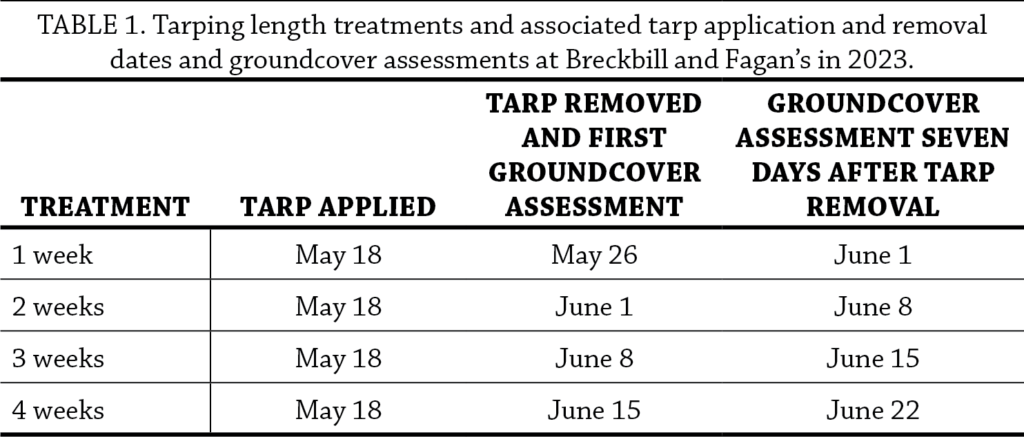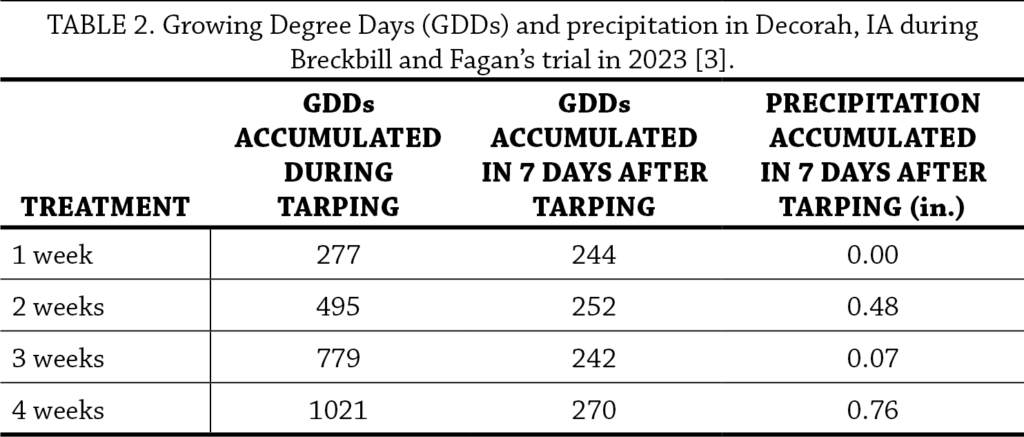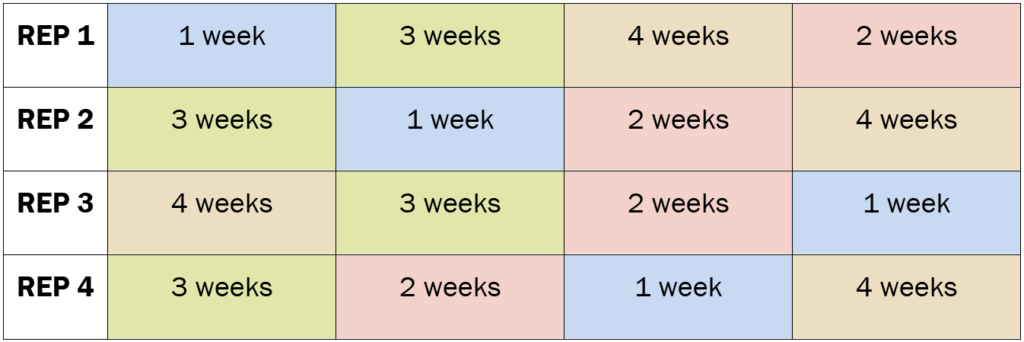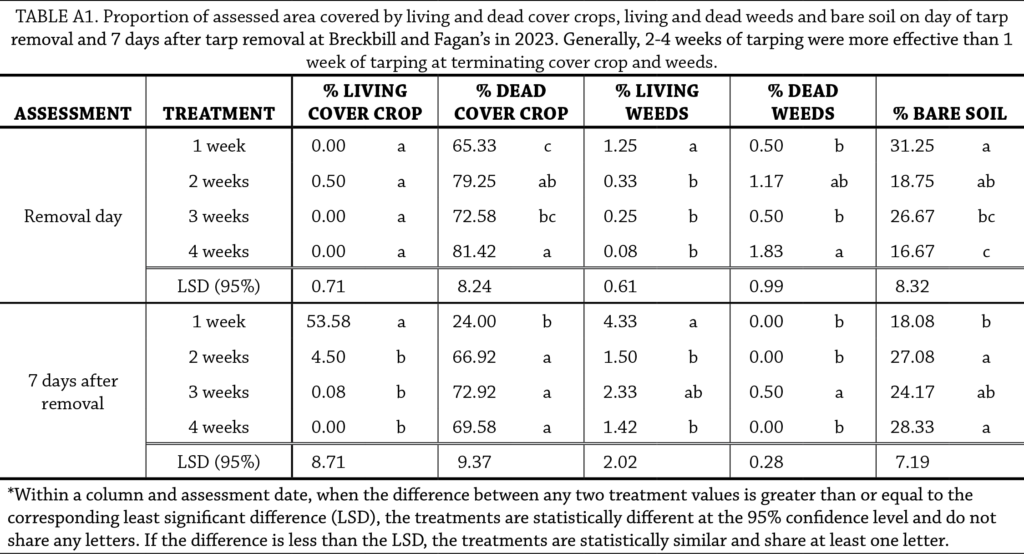This research was funded by USDA-NRCS and Ceres Trust.
In a Nutshell:
- Vegetable farmers are increasingly using tarps as a no-till method for preparing crop beds.
- Farmers Emily Fagan and Hannah Breckbill of Humble Hands Harvest are interested in using tarping to expand no-till practices on their farm. They designed an experiment to investigate how long an occultative (light-blocking) tarp must be on to effectively kill a rye cover crop and set back weeds including perennial Canada thistle.
Key Findings
- Three and four weeks of tarping effectively terminated the rye cover crop and set back weeds for at least 1 week. Two weeks of tarping was statistically just as effective at killing cover crops and preventing weeds as the longer treatments, though there was a small amount of rye re-growth in this treatment.
- One week of tarping was not enough time to effectively kill cover crops and was less effective at preventing weeds compared to two, three and four weeks of tarping.
- Breckbill and Fagan reported that no tarping length they tested effectively killed perennial weeds, but these weeds were set back.
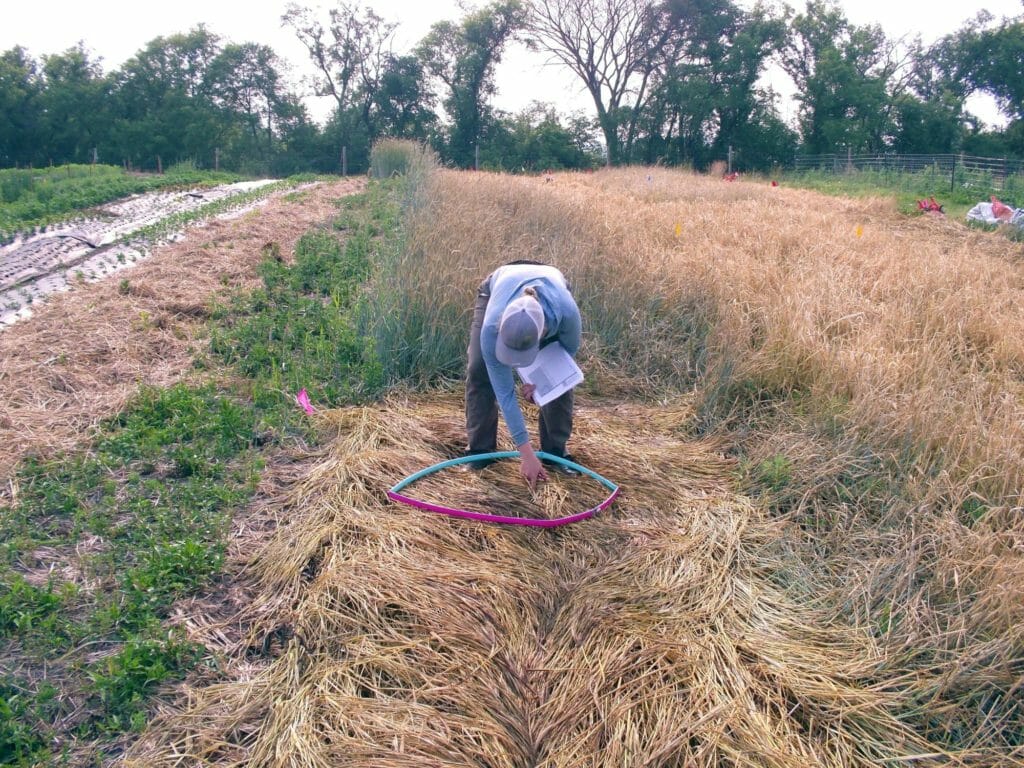
Humble Hands employee Mackenzie Miller assessing groundcover in a treatment plot that was tarped for four weeks. Photo taken June 22, 2023, the day the tarp was removed.
Background
Applying reusable tarps for weeks to months is an increasingly common no-till and low-labor way to prepare a bed before planting. Tarping has many uses including terminating cover crop, killing weeds and creating a stale seed bed, preserving moisture, warming soil, managing nutrients and increasing soil nitrate levels, and speeding up residue decomposition [1]. Tarping can be done using clear tarps, which achieve these management outcomes through solarization or heating, or black tarps, which achieve these outcomes through occultation or blocking light. Even as tarping is gaining in popularity, there is very limited Midwest-specific research to inform producers about the best ways to employ tarps.
Emily Fagan and Hannah Breckbill of Humble Hands Harvest are experimenting with using occultation tarping for no-till cover crop termination and bed preparation as they develop a no-till system for their vegetable farm. They designed a trial to investigate how long they should leave on an occultation tarp to terminate cover crop and minimize perennial weed emergence. They hypothesized that it would take at least three weeks of occultation to adequately kill the cover crop and for weed re-growth to be sufficiently limited to use this method for no-till bed planting. At trial outset, Fagan noted that “Learning more specifically about timing for tarping will help us be more organized and effective about weed control and cover crop termination as we transition to no-till. If we have a clear understanding of how long it takes to kill cover crops and set back Canada thistles, we’ll be able to do less hand weeding and hoeing and save a lot of time and effort over the course of the season.” Though applying and removing tarps is labor-intensive, this labor typically comes in the early spring or late fall and tarping saves time later; researchers in New York have found that no-till tarping can reduce hand weeding 70-80% compared to a no-till without a tarping system [2].
Methods
Design
Cereal rye cover crop was established on Sept. 2, 2022. Rye was crimped by stomping on a t-post prior to tarp application on all treatments on May 18, 2023, just before the cereal rye heads were out. Tarps were then laid out and secured with sandbags. Cooperators tested four different tarping treatments, leaving the tarp on for one, two, three, and four weeks. Replications of each treatment were randomly assigned in four blocks leading to a total of 16 experimental plots of equal size (38 ft by 8 ft; Figure A1). Plot management is presented in Table 1. No crops were planted following tarp removal in any treatment.
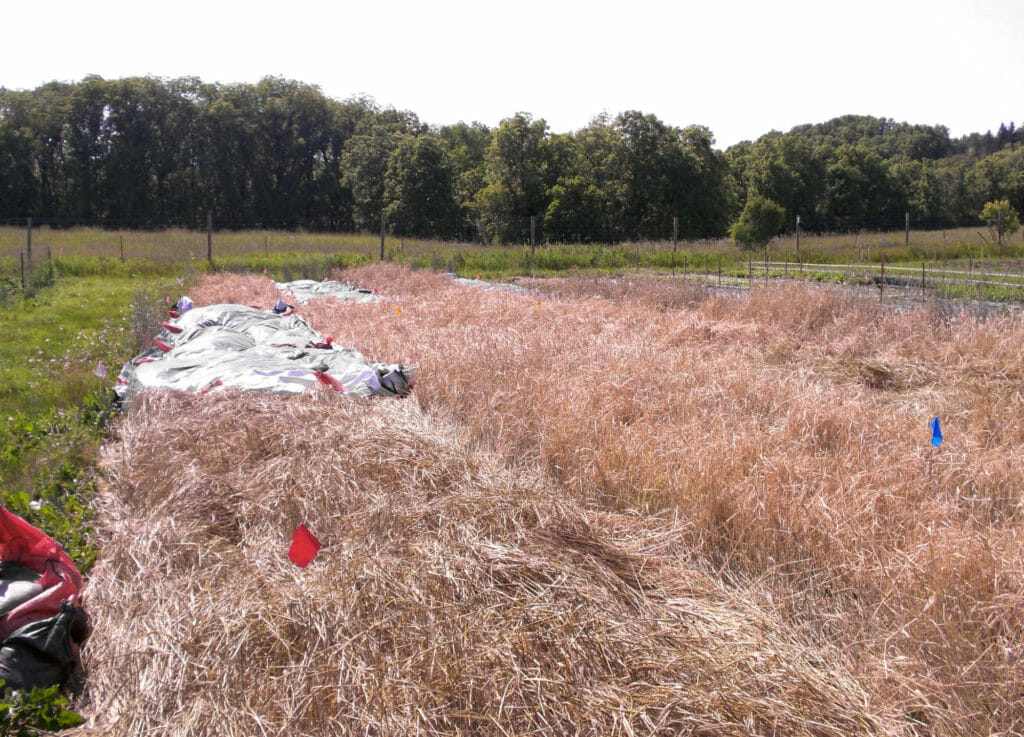
Breckbill and Fagan’s trial field with only the four week tarping treatments still tarped; dead cereal rye is visible in the other treatments, and very few weeds are visible. Photo taken June 15, 2023.
Measurements
Fagan and Breckbill estimated the percent living plants, dead plants, and bare soil within an area (660.52 in²) at three random points within each plot. Area was determined randomly by throwing a hula-hoop 29 in. in diameter into the plots. Groundcover makeup was estimated on tarp removal date and seven days after the tarp removal date.
Weather
To provide some context about solar heat inputs to the tarping termination efficacy data, we calculated the number of growing degree days (GDDs) accumulated during the tarping period. We used 32° Fahrenheit (F) as the base temperature because this is considered the base temperature for cereal rye. GDDs are calculated for each day individually and then summed to get total GDD accumulation. The average daily air temperature is calculated for each day using weather data [3] then the base temperature (32°) is subtracted from the mean, resulting in the total GDDs accumulated that day. Days when average daily air temperature is less than 32°F are assumed to add 0 GDDs.
Data analysis
We used Fischer’s LSD at a 95% confidence level to determine if there were significant differences in percent living cover crop, dead cover crop, living weeds, dead weeds, or bare soil between tarping length treatments at both assessment dates separately. For each metric, the difference between any two tarping length treatments is compared with the LSD. A difference greater than or equal to the LSD indicates the presence of a statistically significant treatment effect, meaning one treatment outperformed the other and the farmer can expect the same results to occur 95 out of 100 times under the same conditions. A difference smaller than the LSD indicates the difference is not statistically significant and the treatment had no effect. We can perform this analysis because the cooperators had completely randomized and replicated experimental designs (Figure A1).
Results and Discussion
Growing Degree Day accumulation was relatively steady over the course of the experiment; for example, the 4-week treatment experienced a bit less than 4 times the number of GDDs as the 1-week treatment (Table 2). Treatments experienced similar numbers of GDDs in the week after tarp removal. However, the two-week and four-week treatments experienced more rainfall than the one- and three-week treatments, which could potentially have influenced weed growth and cover crop regrowth in these treatments.
While no treatment had significantly more living cover crop than any other on the day that tarps were removed, ~53% of cover crop in the one-week treatment was alive seven days after tarp removal (Figure 1, green bars). Percent living cover was significantly higher seven days after tarp removal in the one-week treatment compared to all other treatments, and there were no statistically significant differences in percent dead cover crop between two-, three-, and four-week treatments (Figure 1, red bars; Table A1). However, on average ~5% of plots in the two-week treatments had living cover crop one week after tarp removal. Fagan noted that it “generally seems like one week is not long enough to kill rye… two weeks is better but still not a great termination rate [and] three weeks seems to be the time when the cover fully dies.” Future research could also investigate the role of weather and accumulated GDDs on tarping efficacy; during a hot spell where GDDs are accumulated more quickly than during Breckbill and Fagan’s present trial, might a shorter tarping treatment effectively terminate a cover crop?
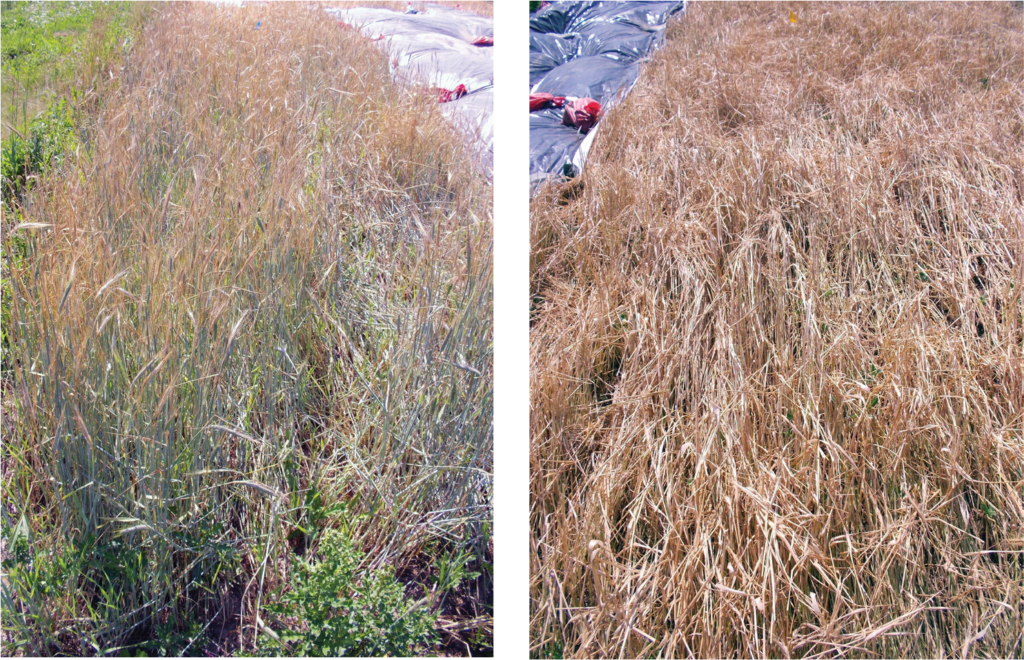
Living cereal rye in a one week treatment two weeks after tarp removal (left) and dead cereal rye in a two week treatment one week after tarp removal (right). Photo taken June 8, 2023.
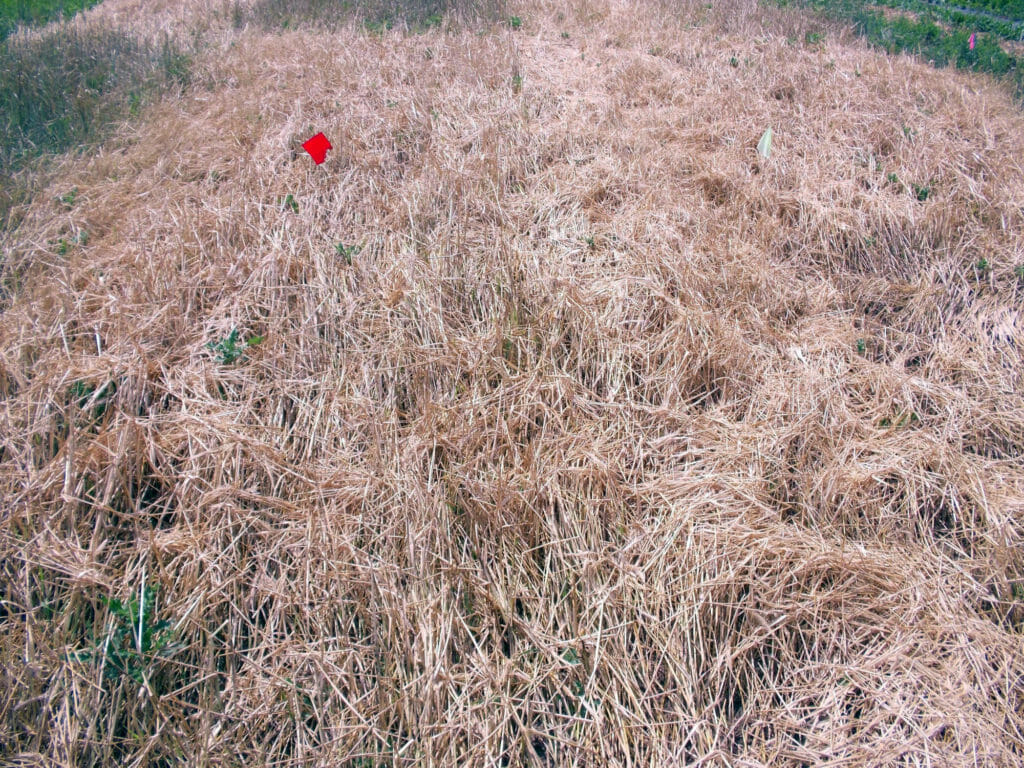
Dead cereal rye cover crop in a three week treatment plot (left, red flag) and four week treatment plot (right, white flag). Living cover crop from in a one week treatment plot is also visible on the far left. Photo taken June 22, 2023.

FIGURE 1. Groundcover was assessed by Breckbill and Fagan on the date of tarp removal (top panel); and seven days after the date of tarp removal (bottom panel). Groundcover assessment dates are provided in Table 1. The letter-rankings for percent dead cover crop (red bars) seven days after tarp removal (bottom panel) were assigned based on the least significant difference (LSD = 27%). Two weeks of tarping was statistically equally as effective at terminating the cover crop as three or four weeks of tarping.
One week of tarping was less effective at reducing the percent cover of living weeds than two, three and four weeks of tarping both at tarp removal and one week after tarp removal (Figure 1, blue bars). However, two, three and four weeks of tarping were all equally as effective at controlling the presence of living weeds at both assessment times (Table A1). Another way to look at it: at least 495 GDDs accumulated during tarping was necessary to successfully control weeds (Table 2). Fagan noted that “this particular location was more weed-free than a lot of parts of our field, but it does appear that tarping is effective for our annual weeds – I didn’t find any of them after tarp removal.” Though they did not record data specifically on the presence of annual and perennial weeds, only total weed coverage, Fagan observed that even four weeks of occultation tarping was not enough time to kill perennial thistles or dandelions based on their assessments seven days after tarp removal. She reported that “they might look dead upon [tarp] removal, but given a week uncovered they greened up again with each of the treatments. They do get set back though – the dandelions look more spindly, and the big stalk of the thistle does die, but side-shoots regrow quickly, and it grows a new shoot from the base.” This observation echoes advice published by researchers in the northeast who report that short-term tarping may need to be used in conjunction with other weed management practices for sufficient control of perennial weed species [1].
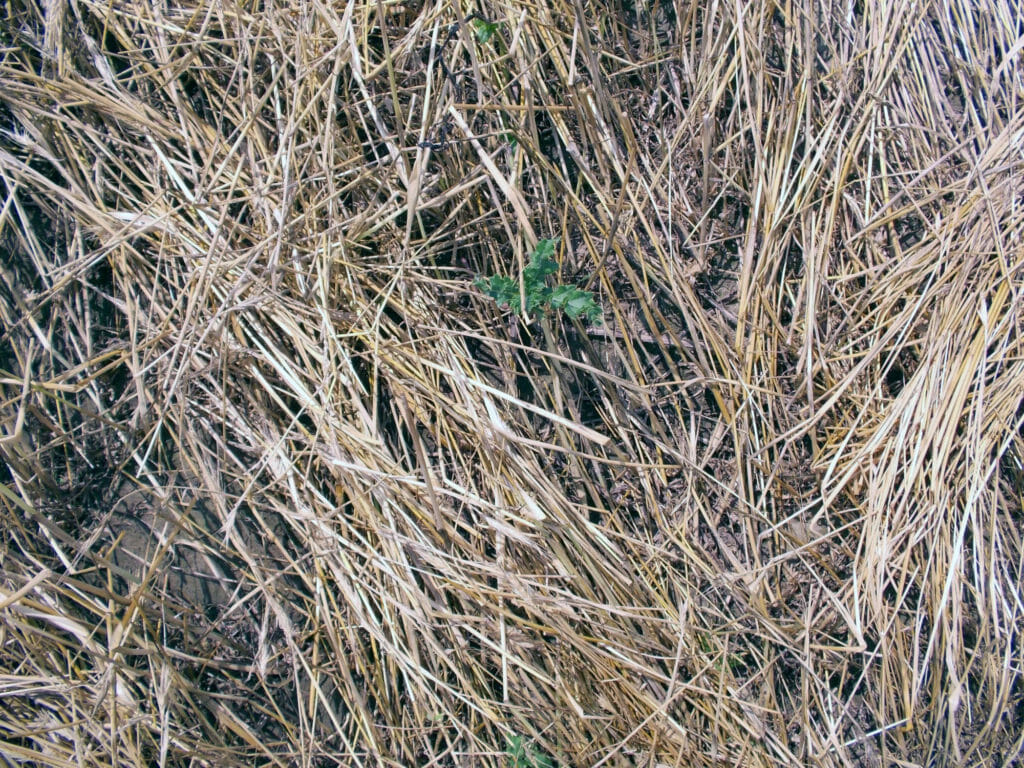
A Canada thistle pokes out of dead cereal rye one week after tarp removal from a four week treatment. Photo taken June 22, 2023.
Conclusions and Next Steps
This trial demonstrates that between two and three weeks of tarping in May is sufficient to terminate a rye cover crop and sufficiently suppress weed growth for a no-till vegetable production system. In May 2023, these tarping durations were associated with 495–779 GDDs accumulated. Fagan reflects that “I have been feeling pretty uncertain about how long a tarp needs to be on in order to be useful… This trial has convinced me that three weeks is a really ideal amount of time to leave a tarp on, but that two weeks will do in a pinch.” She reported that the most valuable aspect of participating in the trial was “having incentive to be organized about answering the questions I have. I could see that tarping had a lot of potential to help speed up our planting system so it felt great to be really focused about figuring it out.” As for tarps affecting thistle growth, it seems that tarping helps set thistle back some but is not a full solution to Humble Hands’ thistle pressure. Fagan is curious to try other methods, perhaps in combination with tarping, in future trials.
Appendix – Trial Design and Weather Conditions
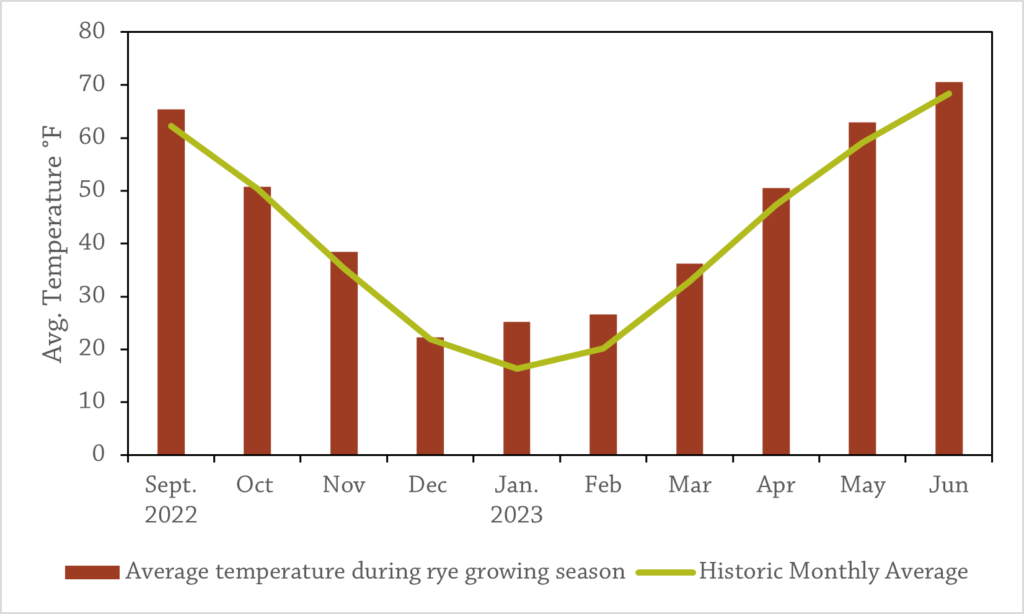
Figure A2-A. Monthly average temperatures in Decorah during the rye cover crop growing season, September 2022 – May 2023 [4].
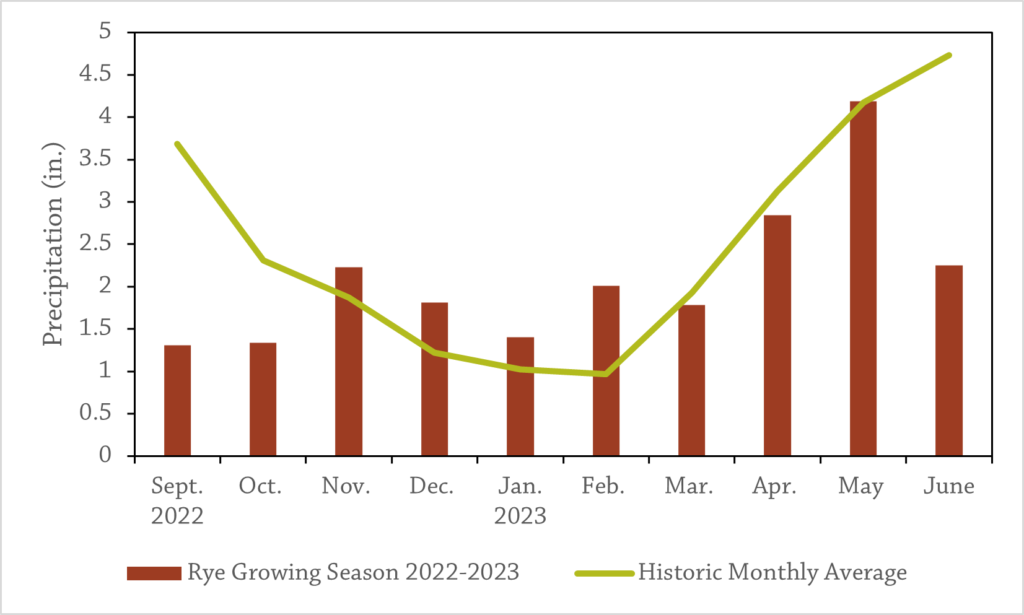
Figure A2-B. Monthly cumulative precipitation in Decorah during the rye cover crop growing season, September 2022 – May 2023 [4].
Funding Acknowledgement
This material is based upon work supported by the U.S. Department of Agriculture, under agreement number NR226114XXXXG004. Any opinions, findings, conclusions, or recommendations expressed in this publication are those of the author(s) and do not necessarily reflect the views of the U.S. Department of Agriculture. In addition, any reference to specific brands or types of products or services does not constitute or imply an endorsement by the U.S. Department of Agriculture for those products or services.
References
[1] N. Lounsbury, S. Birthisel, J. Lilley, and R. Maher, “Tarping in the Northeast: A Guide for Small Farms.” University of Maine Cooperative Extension, 2022. Accessed: Jun. 20, 2023. [Online]. Available: https://extension.umaine.edu/publications/1075e/
[2] R. Maher, A. Rangarajan, M. Hutton, B. Caldwell, M. Hutchinson, and N. Rowley, “Abstract: Comparison of Reduced Tillage Practices for Small-Scale Organic Vegetable Production.,” presented at the Tri-socities, Tampa, FL, 2017. Accessed: Jun. 01, 2023. [Online]. Available: https://scisoc.confex.com/scisoc/2017am/webprogram/Paper108479.html
[3] M. J. Menne et al., “Global Historical Climatology Network – Daily (GHCN-Daily).” NOAA National Climatic Data Center, 2012. doi: http://doi.org/10.7289/V5D21VHZ.
[4] Climodat Reports, “Iowa Environmental Mesonet.” Iowa State University. [Online]. Available: http://mesonet.agron.iastate.edu/climodat/


